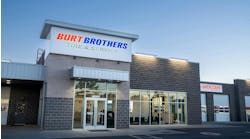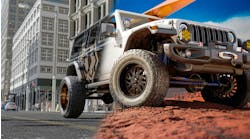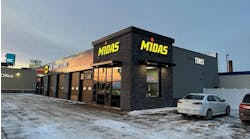As the weather cools, some tire dealers are prepping for winter tire changeover season. But all-weather tires are growing contenders in many climates across the United States. And while the 3-Peak Mountain Snowflake (3PMS) symbol on these tires doesn’t make them an automatic replacement for dedicated winter tires, all-weather tires do provide drivers with another option.
And with another option comes added confusion for consumers. To help clear the way, we asked tiremakers and marketers for their best all-weather tire selling tips. Here’s a roundup of the responses from those who answered our query.
Brandon Stotsenburg, vice president of automotive, American Kenda Rubber Industrial Co. Ltd.: Typically, all-weather refers to tires that offer 3PMS certification, but are not designed as dedicated winter tires. For several years, the North American market has had light truck products, usually A/T designations, that offer this in both metric and LT designations. Only recently have premium brands been able to develop the balanced technologies to offer grand touring tires, which include higher speed ratings (H/V/W), grand touring mileage expectations, plus balanced all-season capabilities for braking, handling, ride/noise and the 3PMS certification. The additional challenge for manufacturers is to offer retailers and consumers the aesthetics that resemble a grand touring tire, not a dedicated winter tire.
Kenda offers multiple tires that are designed to provide added benefits for all four seasons, including 3PMS certification. Our first tip to tire dealers is that four-season capability is a “plus” benefit for the consumer to provide cold weather and winter capability beyond the standard all-season tires that everyone knows. Kenda has found that consumers get confused by “all-weather” (being) the same as “all-season.” We recommend changing the discussion to the “bonus” of four-season capability to educate and allow differentiation for year-round driving. If necessary, the retailer can further explain the 3PMS certification and its advantages and differences when also stamped on a dedicated winter tire versus a four-season tire.
Our second tip for retailers is to confirm the tire performance of the brands that our offered as “all-weather” to assure that they meet the local market needs for a grand touring tire. Make sure that the aesthetics and performance will allow you to sell it year-round as a primary touring, H- or V-rated tire which offers low noise, a good ride, the expected wear capability, strong wet/dry braking and handling, which will be embraced for its aesthetics by consumers. When a retailer asks the consumer what driving needs they have or concerns they have had with their current tires, they can focus the benefit conversation on the performance of the four-season tire that will meet their needs, without having to change over to dedicated winter tires in most markets.
Karl Jin, divisional head of passenger and light truck tire products and pricing, Apollo Tyres Ltd.: For drivers in regions that don’t experience harsh winters with extended periods of snow, the expense and inconvenience of a seasonal changeover to winter tires can lead to them running tires that fall short when a storm hits or when they experience an unexpected period of exceptionally cold conditions. Switching to an all-weather tire like the Vredestein Quatrac Pro gives drivers the dry and all-season performance that they are accustomed to, with the added safety of improved wet traction and stopping distances in winter conditions.
All-weather tires are a perfect solution that deliver every benefit of a traditional all-season tire, with additional winter performance advantages that have traditionally been restricted to dedicated winter tires. If harsh conditions are the norm, winter tires are still recommended, but for many drivers, all-weather tires provide a best-of-all-worlds solution.
Ian McKenney, senior product manager, Bridgestone Americas Inc.: Educate the consumer. Before recommending an all-weather tire, it’s important that tire dealers ask questions to understand each consumer’s individual performance needs. After assessing whether an all-weather tire is the best option for a specific customer, tire dealers should first educate the consumer as to why an all-weather tire is the better option over an all-season tire, based on their needs. All-season tires are designed to perform in a wide variety of temperatures and conditions but may prioritize attributes, such as wear and ride comfort, over snow performance. All-weather tires are also designed for year-round performance and are 3PMS-certified, meaning they offer more advanced snow performance than all-season tires. All-weather tires are suited for drivers in regions that experience all four seasons, including some snow. Positioning all-weather tire applications as “the jack of all trades” will help consumers who experience moderate winter climates understand the versatility of the tire in year-round weather. (The Bridgestone WeatherPeak tire delivers the comfort and quiet of a touring tire with the added benefit of all-season readiness.)
Additionally, tire dealers can sell a set of all-weather tires by emphasizing the value of the tire itself, not the price. By positioning the all-weather application as a tire that delivers year-round performance without compromising wear life and offers a quiet, comfortable ride, consumers will understand the value of the tire. Highlighting the 3PMS rating on the all-weather tire is also important as it can replace the need to buy a separate set of dedicated winter tires in some regions, which can demonstrate even more value to the customer. This will help consumers recognize that the tire is an investment and not just a purchase. Consumers typically don’t want to trade off safety, comfort and performance, so ensuring the customer understands the tire’s value will help mitigate any price objections they may have.
Understanding the all-weather tire’s role and value within the touring tire segment will allow tire dealers to effectively recommend an all-weather application to its target consumer.
Philipp Schrader, product manager for touring and U.S. winter tires, Continental Tire the Americas LLC: Understanding the specific customer needs is key, (as is) taking note of specific driving habits, typical weather conditions he or she encounters and the performance needs. Once the customer’s concerns are fully uncovered, highlighting the features and benefits of all-weather tires that directly address these concerns, as well as emphasizing the tire’s performance in both summer and winter conditions and safety benefits, will help close the deal. If the individual lives in an area with mild winters and/or regular rainfall, all-weather tires might be the perfect fit for them.
Clearly communicate the unique value proposition. Explaining that all-weather tires are touring tires with a 3PMS (certification) - which qualifies them for severe winter weather conditions, while also offering exceptional dry and wet traction and enhanced tread life - are all part of what makes all weather tires such a great choice. It is also important to highlight the added convenience and cost savings versus all season/summer and winter tires. Seasonal changes are no longer needed and only one set of tires needs to be purchased, which tends to be a major motivator for consumers. Explaining the economic, convenience and safety benefits of all-weather tires should convince your customer that this product is the right choice for him/her.
Lou Monico, vice president, Canadian sales and marketing, Giti Tire (USA) Ltd.: It is important to explain the difference between all-weather and all-season tires to consumers. All-season tires are designed to perform well in both summer and winter, but they are not as effective as all-weather tires in harsh winter conditions. All-weather tires, on the other hand, are designed to perform well in both summer and winter and they carry the 3PMS symbol, which indicates that they meet the industry's severe snow service requirements.
It’s important to emphasize the importance of considering the driving conditions in their area. If the consumer lives in an area with harsh winter conditions, all-weather tires may be a better option. If they live in an area with mild winters, all-season tires may be sufficient. You must highlight the fact that all-weather tires are a good compromise between winter and all-season tires. They provide better traction in winter conditions than all-season tires, but they are not as effective as winter tires. Explain that all-season tires typically last longer than all-weather tires, but they may not provide the same level of performance in winter conditions.
Encourage the consumer to check the tire ratings for models that excel in the areas that matter most to them, such as braking, handling, ride comfort and noise.
Andrew Lau, product marketing manager, Goodyear Tire & Rubber Co.: All-weather tires — all-season tires that are designated with the 3PMS symbol — are better-suited for adverse weather conditions than a standard all-season tire and can be used year-round.
Moonki Cho, product manager, Hankook Tire America Corp.: Closing a sale, especially for all-weather tires, can be challenging without correctly qualifying the customer and explaining the value that an all-weather tire provides. Dealers should think of an all-weather tire as an all-season tire with enhanced winter capabilities. For the customers that live in areas where fall and spring seem more like a long winter, all-weather tires could be a great option.
Still, for truly challenging winter driving and heavy snow, a winter tire can’t be beaten. But as an alternative, all-weather tires provide year-round traction with extra confidence while driving on snowy roads, while saving drivers the hassle of changing out and storing sets of tires for a season.
Coy Jones III, B2B customer marketing manager, Michelin North America, Inc.: The key to determining which tire to equip for all weather considerations is the possibility of infrequent winter weather. Over the long run, the customer can eliminate the inconvenience of having to switch between an all-season/summer tire to a winter tire when the infrequent cold weather occurs. Ultimately, this investment leads to saving the customer time and money by having the correct tire application for their needs.
This approach leads to educating the buyer on the balance provided by an all-weather pattern, from the durability to handle inclement weather or winter storms to the long family vacations during the summer months. An all-season tire or summer tire may be less expensive, with slightly better dry grip, and a winter tire would provide an enhancement to the traction in snow/ice, but the all-weather (tire) provides that delicate balance to handle the year-round needs in the majority of geographies, without the need to purchase and mount an extra set of tires each year.
Steve Bourassa, director of products for North America, Nokian Tyres Inc.: All-weather tires should serve as an upgrade for drivers who prefer a year-round solution, not a downgrade from dedicated winter tires. In sustained winter conditions, nothing is safer than a pure winter tire. For that reason, dealers shouldn't replace a winter sale with an all-weather sale. However, all-weather tires represent a good upgrade from all-season tires for drivers who visit winter or have winter weather visit them. It pays to differentiate all-weather tires in their own segment — better than all-season tires in snow, but not a sufficient replacement for winter tires in sustained, severe winter weather.
Regular rotations are critical to extending the life of all-weather tires. While it's important to rotate any tire, it's especially valuable for all-weather tires given their unique properties. They are versatile tires whose performance will be more effective, for longer, with regular love and maintenance.
Nick Gutierrez, sales director, Sentury Tire USA: Train your sales team to inform customers of the benefits of purchasing a tire with a Nano-Grade silica compound and the 3-Peak Mountain Snowflake certification. Today, drivers can attain performance beyond 3PMSF certification by purchasing tires that also have a Nano-Silica compound in addition to the 3PMSF. When you combine these two features, drivers can rest assured that they have maximized performance, stability, and safety in the snow. Until the USTMA identifies a higher certification, combining these two features is the best recommendation for drivers.
Point customers to look for all-weather engineering with continuous zigzag-type grooves on the shoulders and tread, which improve a tire’s ability to evacuate rain, mud, and snow — and its overall handling ability in snowy conditions.
Tsuyoshi “TJ” Johnson, Falken brand passenger tire product manager, Sumitomo Rubber North America Inc.: Our first tip to help dealers get more customers on all-weather tires is to focus on convenience. Most North American drivers utilize the same set of tires year-round. We believe this is largely due to convenience and value. Consumers value the time and money saved by using the same set of tires year-round and that’s unlikely to change. In a society that’s become so accustomed to convenience, it’s difficult to persuade folks to change their tendencies to do something less convenient. Fortunately, all-weather tires can offer drivers a safer alternative to driving in all-season conditions, without compromising convenience.
For folks living in regions that experience harsh winter conditions (i.e. the Northeast and Mountain states), a tire capable of performing throughout the winter months is critical. All-weather tires not only offer an elevated level of snow traction, but also a compound specially formulated to offer good dry and wet traction in freezing temperatures. Having the option to equip their vehicles with one set of all-weather tires year-round can save time and money.
Meanwhile, there’s another customer segment who may not require 3PMSF-rated tires daily, but could benefit from having them for other reasons. One example is the Southern California native who spends weekends snowboarding at local mountains. All-weather tires can save them from having to purchase and utilize tire chains after a snowstorm. Another example is someone living in a mild-weather state who regularly makes the trek to a northern state. This could be a student who’s attending a university up north and regularly drives home (down south) during the holidays. It would be comforting to know the student is on a capable tire that can power through the wintery conditions and still perform in mild conditions.
Our second tip to help tire dealers sell more all-weather tires is to ensure customers know that all-weather is already a proven new segment in the market, showing signs of increased usage amongst drivers throughout North America. According to touring tire market data from the first half of 2023, we can expect an increase of roughly 20% year-over-year of consumers converting to all-weather tires, lending itself to the consumer acceptance of the all-weather category in our market.
Kyle Sanders, director of product planning and development, TBC Brands LLC: Tire dealers can share with their customer that purchasing all-weather tires may save them from needing to purchase snow tires and eliminate the need to alternate tires between seasons.
Tire dealers, however, need to ensure the climate in which the customer resides is suitable for all-weather tires. Although the all-weather segment is growing, driving conditions may dictate that a snow tire is best.
Joaquin Gonzalez Jr., president, Tire Group International LLC: Understand the customer's specific needs. By asking the right questions and actively listening, you can get a clear understanding of what the customer is looking for in all-weather tires. Inquire about their driving habits, the usual weather conditions they encounter and any specific requirements they might have. This information will allow you to recommend the most suitable all-weather tires from your inventory, making the customer feel heard and understood.
When presenting all-weather tires to the customer, focus on emphasizing the benefits and features that make them a great choice. Discuss the tire's performance in different weather conditions, its durability and longevity, any special traction or grip technology it offers and how it can enhance the customer's driving experience. Providing clear and compelling information will give the customer confidence in their purchase decision.
Sonny McDonald, senior national training manager, Toyo Tire U.S.A. Corp.: Anytime we make a tire sale, we need to ask the customer some basic qualifying questions to determine which tire will provide the best overall performance for their needs. “What is the worst driving condition you will face: rain, sand, mud, gravel, snow, ice, etc.?” If they answer snow or ice, the next question should be: “Do you run a separate set of winter tires?” If the customer says no, that is the perfect intro to discuss the features and benefits of having an all-weather tire. I call it “traction on demand.”
Kevin Nguyen, manager of product planning, Yokohama Tire Corp.: If a customer lives in an area with mild winters, an all-weather tire can help save them money by not having to purchase dedicated winter tires. They will notice the savings by not having to purchase a second set of tires just for winter, not having to pay for storage for the second set of tires when not in use and not having to pay installation costs to swap the tires back and forth.
Mileage warranties and comfort are not sacrificed. All-weather tires have comparable mileage warranties and provide the same on-road comfort as an all-season tire, but with additional winter performance.




